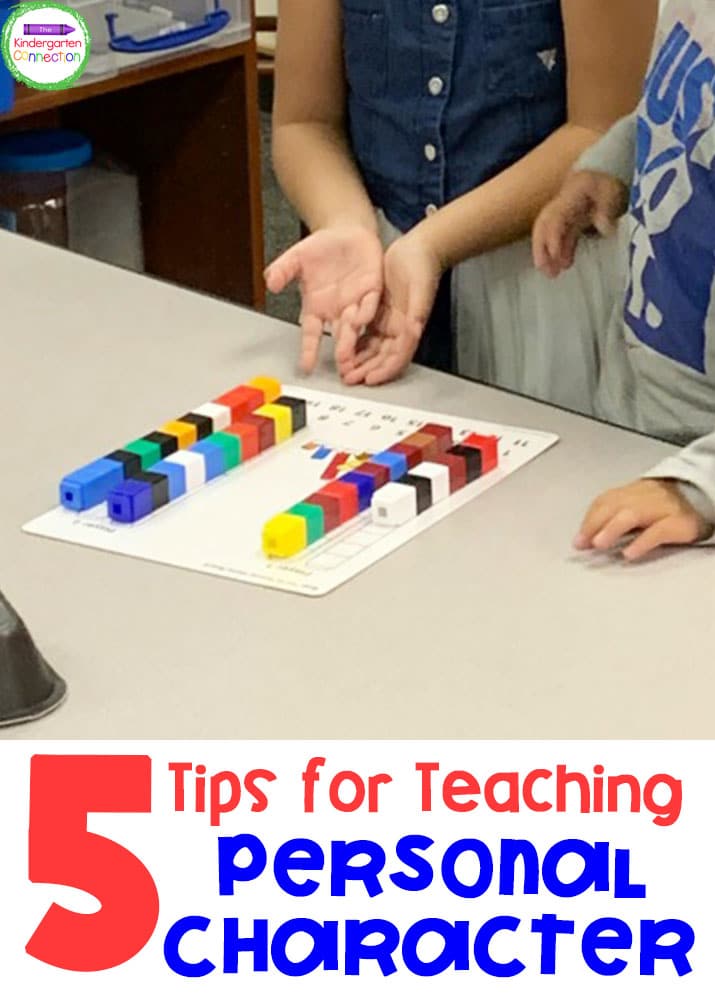5 Tips for Teaching Personal Character to Kindergartners
This post contains affiliate links for your convenience. View our full disclosure policy here.
Kindergarten is more than just the alphabet and numbers. Part of teaching kindergarten includes teaching children about how to be good people. About how to be kind and respectful, helpful and compassionate, among other traits. Of course, in kinder that looks like teaching kids to use napkins, to help others, to speak kindly, etc. Basically, we teach little people to be humans. Here are 5 tips for teaching personal character to kindergarteners!
*Guest post by Sarah from Stay at Home Educator

Personal Character in Kindergarten
A few months after my daughter started kindergarten, I was doing her hair before school when she said to me, “Mom, Danica never does her hair. Ever. It’s always a huge mess.”
The school my kids attend is not very diverse. My daughter is of the minority, if you will, due to our income. She is at a school that is 100% free and reduced lunch and breakfast with over 65% of the kids actually living below the poverty line, however my family doesn’t come close to qualifying for free lunch or breakfast. My kids pack their lunches to school and they eat a healthy, low sugar breakfast of old fashioned oats and berries most mornings.
As I gently ran the comb through her silky blonde hair that smelled like her coconut conditioner, I responded, “You know, not everyone has a mom to do her hair. Or, maybe Danica does have a mom, but her mom has to work in the mornings and she can’t be home to help her get dressed. Maybe Danica’s mom is sick and can’t always help her.”
My daughter looked at me a little bewildered. Clearly, up until this point, she had been a little sheltered and this year was going to be full of conversations like this one.
Which is a really good thing.
Because it’s important for kids to understand that not everyone is just like them. And how does that understanding come? By teaching personal character.
5 Tips for Teaching Personal Character
Character education should be a part of any program, however, some schools don’t offer teacher support. Here are five tips for teaching personal character.
Pillars of Character
Start by defining which traits you would like to highlight and teach throughout the school year. The Josephson Institute of Ethics defines the main pillars of character to include: trustworthiness, responsibility, respect, caring, fairness, and citizenship. Courage, diligence, and integrity are also sometimes included. I have seen some schools include compassion, honesty, cooperation, perseverance, and tolerance, too.
Many schools like to choose a set of nine traits, teaching or focusing on one each month of the school year. Now, I gave you more than just nine ideas above, so pick and choose the character traits that are most important for your school’s demographics.
Turn Classroom Rules into Character Traits
Many classrooms still have rules like, “Raise your hand before speaking,” or “Clean up after yourself.” These are important rules, but revising the wording a little can make them encompass character training as well. For example, “Be respectful of others, yourself, and things” or “Persevere and always do your best work.”
Most importantly, be a good example yourself. To teach your students personal character traits, then you must also exhibit them. Speak kindly to your students, be punctual and prepared, be tolerant of others, etc.
Encourage Good Role Models
Children are always looking for role models, no matter what kind of home they come from. Children might look up to professional wrestlers or baseball players. They might look up to their parents or older siblings, or they might admire characters they see on TV or they read about in books.
Be sure to point out these role models’ good character traits. With the influence of social media, it is becoming easier and easier to keep up with professional sports role models, like this interview with Tim Tebow, for example. Children love to tell stories about their families, so take the time to really listen and then give a genuine comment referring back to the character traits you’re trying to teach. “Your sister is really kind, isn’t she?” or “Wow, it sounds like your cousin worked really hard to prepare for her recital” mean a lot to children and go a long way.
Create a Caring Community
A caring attitude is a must in teaching character. Children need to see respect and caring modeled for them, as well as implemented in the classroom via rules. A caring community can be encouraged by having a zero-tolerance policy on name-calling and character assaults or bullying. Give all children a chance to say their piece, and make sure that all students are included in activities. Describe the “random acts of kindness” concept and reward students when they demonstrate it.
Create Opportunities for Volunteering
One of the best way to help kids build good character is to give them opportunities to volunteer, and not just for the “fun” stuff, like passing out papers. Take some time in your classroom to highlight the virtues and importance of volunteerism. Invite students to volunteer to clean up scraps of paper from the floor, to sweep the entry way, or to count math manipulatives into groups.
You can also start volunteer programs in your classroom and school. Allow students to read or tutor younger children, assist in the computer lab, assist with reading comprehension, or provide support for students recovering from an illness or injury.
Many schools have a student council in the upper grades who have these programs up and running, so ask how your kindergarteners can help out, and of course, you can always start your own program that your class is in charge of, like collecting food for the local food bank. Students can help design the program and collect food other classes bring in, as well as count the food, pass out informational flyers, and so on.
Sending Good Character Home
I am still thinking back to that conversation I had with my daughter about her classmate, Danica. It was important for me to teach my daughter that Danica was different from us, and that is okay. That she may have messy hair on the outside but a kind and gentle heart on the inside. That we never say mean things to other people. even it they may be true. That maybe Danica would like my daughter as a friend and could be invited to come and play at recess.
To help parents teach or reinforce personal character traits at home, try sending out monthly newsletters with ideas or game for parents. Sometimes, even a dialogue example is important to teach parents. Or, try sending home a list of books that can easily be checked out from the school or local library. Here are some of my favorite books that teach character:
- Howard B. Wigglebottom series by Howard Binkow (early elementary)
- Harry the Happy Mouse by NIG K (picture book)
- Girls to the Rescue series by Bruce Lasky (elementary)
Want unlimited access to even MORE of our activities and resources? Join us in the Print and Play Club!
Your planning will be so much easier with instant access to:
- hundreds of printables
- every TKC resource
- video lessons
- a digital games vault
- Pre-K and TK Scope & Sequence
- a PLAYlist of fun songs AND activities
- professional development
- additional teacher resources…
Be sure to request an invitation so that you don’t miss your chance to be part of the best early childhood club around!
- The Literacy-Rich Classroom - December 15, 2022
- Teaching Phonics – Your Questions Answered - November 17, 2022
- 22 Telltale Signs of a Reading Disability - November 2, 2022

